
A Brief History of the Breed
Bassets originated in sixth-century France, a country known for its many strains of hounds. Most strains had a tall version as well as a short-legged size under sixteen inches, which were called “basset” (bas in French means low-set). Both the Basset Hound and its long-legged cousin, the Bloodhound, are thought to be descendants of the famed St. Hubert hounds. St. Hubert, a churchman, was the patron saint of the hunt, who set out to develop a new strain of hound, which looked similar to today’s Bloodhound. Many authorities feel the Basset was a result of a mutation in the St. Hubert strain. This genetic deviation produced a short-legged, dwarfed hound, whose slower movement and low-set form was to prove useful for hunters on foot in search of small game. With his long ears helping to stir up the scent, packs of Bassets were used to drive small prey, such as rabbit and hare, from dense undercover into open terrain where hunters could move in for the kill with spears (shown below), nets or clubs. The sport of pack hunting with Basset Hounds continues to this day in France and England.
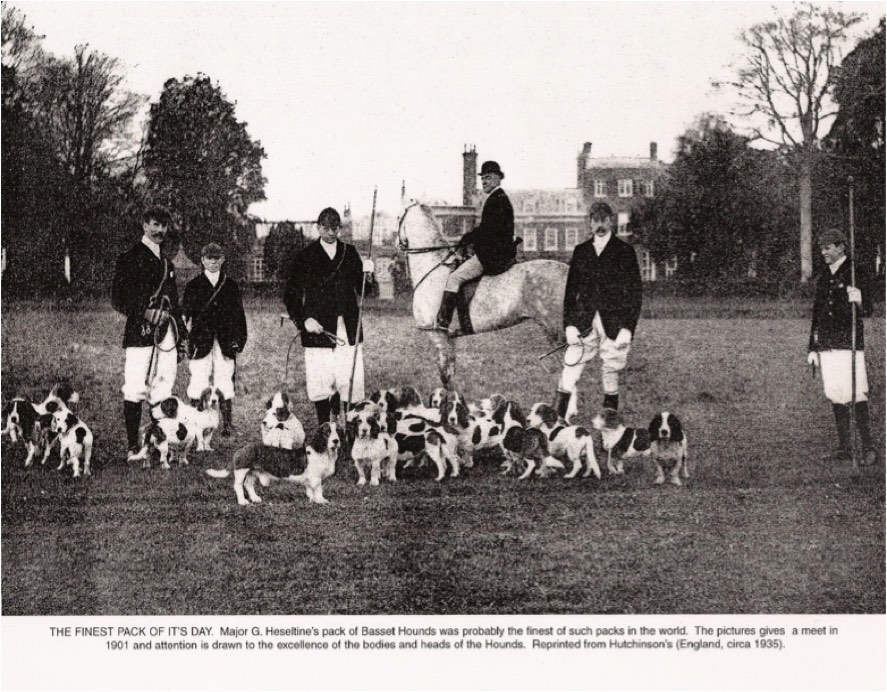
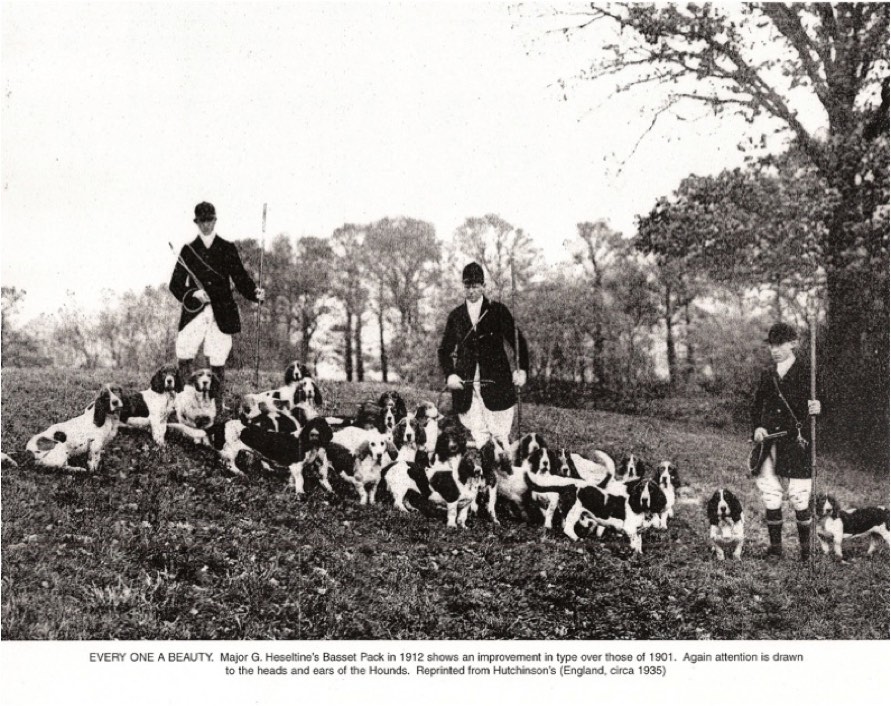
The Basset was not familiarly known to British sportsmen before 1863, in which year specimens of the breed were seen at the first exhibition of dogs held in Paris, and caused general curiosity and admiration among English visitors. The two popular Basset breeders at this time were M. Lane and the Count Le Couteulx. The basset pictures here were shown by Monsieur Pierre Pichot in 1863. He was a colleague of Count Le Couteulx.
Basset Hounds in the Show Ring
Dogs and All About Them published in 1934 states: As with most imported breeds, the Basset-hound when first exhibited was required to undergo a probationary period as a foreign dog in the variety class at the principal shows. It was not until 1880 that a class was provided for it by the Kennel Club.
The following is an excerpt from the chapter on basset hounds in Cassell's Illustrated Book of the Dog published in 1881. This is perhaps the very first Standard for basset hounds in England. It was republished in The New Book of the Dog, Chapter XXVII in 1907 which states, “Perhaps the most explicit description of the perfect Basset-hound is still that compiled twenty-five years ago (in 1882) by Sir John Millais. It is at least sufficiently comprehensive and exact to serve as a guide.” It’s very interesting to compare it to the current AKC Standard.
The Basset, for its size, has more bone, perhaps, than nearly any other dog.
The skull should be peaked like that of the Bloodhound, with the same dignity and expression, nose black (although some of my own have white about theirs), and well flewed. For the size of the hound, I think the teeth are extremely small. However, as they are not intended to destroy life, this is probably the reason.
The ears should hang like the Bloodhound's, and are like the softest velvet drapery.
The eyes are a deep brown, and are brimful of affection and intelligence. They are pretty deeply set, and should show a considerable haw. A Basset is one of those hounds incapable of having a wicked eye.
The neck is long, but of great power ; and in the Basset a jambes torses the flews extend very nearly down to the chest. The chest is more expansive in the Basset than even in the Bulldog, and should in the Bassets d jainbes torses be not more than two inches from the ground. In the case of the Basset a jambcs demi-torses and jainbes droites, being generally lighter, their chests do not, of course, come so low.
The shoulders are of great power, and terminate in the crooked feet of the Basset, which appear to be a mass of joints. The back and ribs are strong, and the former of great length. The stern is gaily carried like that of hounds in general, and when the hound is on the scent of game this portion of his body gets extremely animated, and tell me, in my own hounds, when they have struck a fresh or cold scent, and I even know when the foremost hound will give tongue.
The hind-quarters are very strong and muscular, the muscles standing rigidly out down to the hocks.
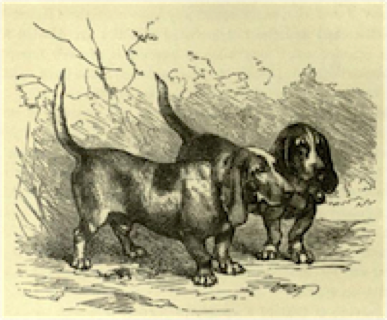
Basset a Jambes Torses
The skin is soft in the smooth-haired dogs, and like that of any other hound, but in the rough variety it is identical with that of the Otter-hound's.
Colour, of course, is a matter of fancy, although I infinitely prefer the 'tricolour', which has a tan head and black-and-white body.
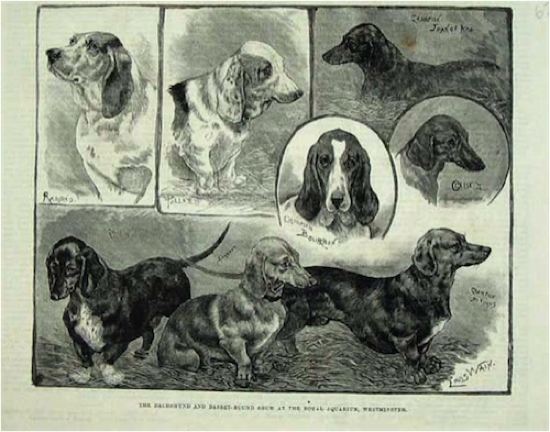
Aquarium Westminster Show 1886
From The Illustrated London News, May 18, 1886.
Note: Basset hounds, a basset griffon vendee and dachshunds were shown together in the early shows.
Bassets are divided into two distinct breeds the Basset Français and the Basset Allemand, which is the German Dachshund. So let us put this latter aside without further ado.
Now the Bassets Francais are divided into two classes the Basset a poll ras (smooth-coated), and the Basset d poll dur, more commonly known as the ' Basset Griffon.' From Cassell’s Illustrated Book of Dog.
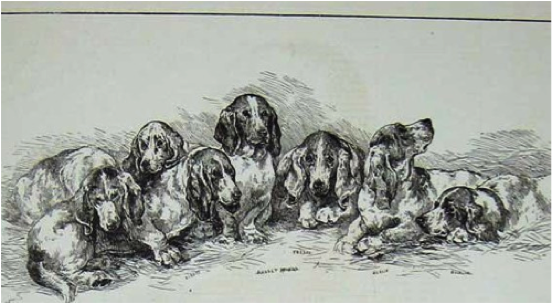
Louis Wain 1887 illustration from the Kennel Club Dog Show at the Crystal Palace, London, England
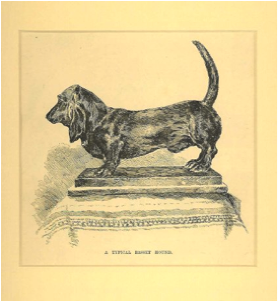
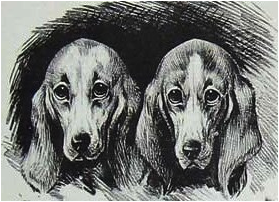
This print, taken from a magazine published in 1888, was intended to portray the "standard" for the breed. On the reverse is a cutting from the magazine, written by the Secretary of the Basset Hound Club at that time, explaining the reasons why it was considered to be appropriate to describe the ideal breed type in the form of a picture rather than in words.
1890 illustration by Louis Wain of basset hounds in a dog show at the Crystal Palace, London, England.
British Dogs, Their Points, Selection and Show Preparation, Chapter XXII - The Basset-Hound published in 1903, is a source for information on the origins of basset hounds. Contrary to all newer books on the subject the author dispels the idea that modern Basset Hounds have come about as a result of the mating of a bloodhound with a Basset (Hound). The following quote from that book sounds familiar.
I have now several clever Bassets a jambes torses (wholly crooked fore legs) in my mind's eye, and their general description would be about as follows: Height, between loin, and 15in. at shoulder; longish barrels; very crooked fore legs, with little more than an inch or two of daylight between the knees; stout thighs; gay sterns; conical heads; long faces; ears long enough to overlap each other by an inch or two (and more sometimes) when both were drawn over the nose; heavy-headed rather, with square muzzles; plenty of flews and dewlap; eyes deep set, under heavy wrinkles; fore paws wide, and well turned out; markings, harepied and white, black tan and white, tan and white, black with tan eyebrows, and tan legs and belly, etc. in short, all the varieties of hound markings will be found among them....
I hope that, in breeding Bassets for hunting purposes, owners will not neglect the heavy and somewhat ungainly appearance that they should have, and gradually get them higher on the leg and lighter in bone and body; by so doing they may increase the speed, but they will lose the endurance, and they will in time be nothing better than deformed Beagles.
I have already noticed a tendency in this direction in packs. If Bassets are not fast enough for a man, let him by all means keep Beagles instead. You cannot expect a Clydesdale to go as fast as a thoroughbred, nor would you think of breeding them to do so. Keep each to his real work: both are good, but their style may suit different tastes.
Basset Hounds as Pets
Perhaps the earliest mention of basset hounds as pets came in The Illustrated London News, July 5, 1884. The illustration below from that paper was titled “A NEW DOG-FANCY THE BASSET HOUNDS”.
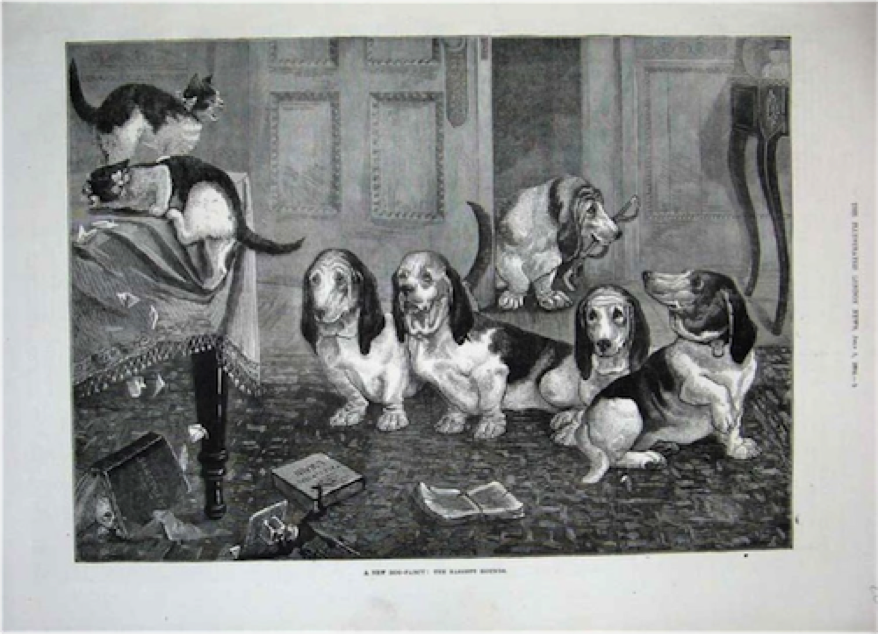
During the Victorian era basset hounds were introduced to the British Isles. Lord Galway imported two of the "French Bassets" into England in the late nineteenth century as did Sir Everett Millais and others. Millais, who established an ambitious breeding program in conjunction with other Basset fanciers, is considered the father of the breed in England. He exhibited his first Basset at a show in 1875, but it was not until the Wolverhampton show in 1880 that enough examples of the breed were entered to attract broader public interest. Interest in the breed was also furthered when Queen Alexandra (pictured right) obtained several Bassets for her kennels at her estate in Sandringham. Within a generation of their introduction even British citizens who did not hunt owned basset hounds. Queen Victoria even had a few basset hounds of her own.
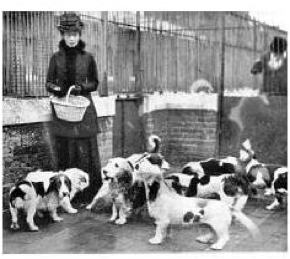
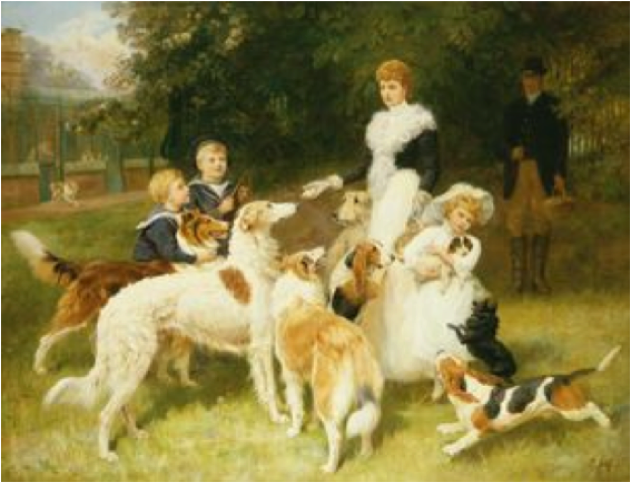
Queen Alexandra with her grandchildren and dogs, in a painting by Frederick Morgan and Thomas Blinks of 1902. This shows the Queen outside the kennels at Sandringham, surrounded by a variety of dogs including a Borzoi, two collies and two basset hounds.
Basset Hounds in America
In 1883 George Krehl exported a Basset Hound named Nemours (shown below) out of Jupiter and Vivien to the United States. In the following spring, 1884, the Westminster Kennel Club kindly made a class for Basset Hounds at the New York Show, and Nemours made his bow to the American public. By 1885 he was a Champion. Jupiter was also the father of some other early imports that were sold to a Texas cattle-baron, Lord Aylesford. Mr Gilbert of Connecticut also had a hound Chance, by Jupiter. The first Basset Hounds to be recorded by the American Kennel Club (AKC) were registered in 1885.
The American Book of The Dog, The Basset Hound by Lawrence Timpson published in 1891 may be the first published material on the breed in this country. It contains an early breed Standard and point scale for judging basset hounds.
Below is given the standard and scale of points of the Basset Hound :
Value Value
Head 25 Coat 10
Neck and chest 10 Color 10
Fore legs and feet 15 Size and symmetry 15
Ribs and loin 10 Hind quarters and stern 10
Total 100
■ Head — resembling that of the Bloodhound in shape and dignity of expression, long, rather narrow, and well peaked, with little or no stop. Jaws long, strong, and level; teeth rather small. Nose usually black; but some good ones have had considerable white about theirs. Mouth well flewed. Ears long, large, and soft, hanging like the softest velvet drapery. Eyes are a deep brown, very expressive, rather deeply set, and showing a good deal of haw; expression affectionate, intelligent, and good-humored, though occasionally reflective and melancholy.
■ Neck and chest — The neck is long, but very powerful, with flews extending nearly to the chest. The chest is well developed, overhanging, and extending to within nearly two inches of the ground
■ Forelegs and feet — The shoulders are of great power. Legs very short, and turning inward at the knees; and the feet, which appear to be a mass of joints, considerably bent out.
■ Ribs and loin — The back and ribs are strongly put together, and the former is of great length.
■ Hind quarters and stern — The hind quarters are very strong and muscular, the muscles standing out, and clearly defined down to the hocks.
■ Coat — The skin is soft, and the coat smooth and close, though moderately hard and very weather-resisting in quality, and when the dog is in condition, showing a beautiful natural gloss.
■ Color — The tri-color, which has a tan head and a black and white body, is much preferred; but they come in all the varieties of white and black-and-tan.
■ Size and symmetry — Bassets come in all sizes, from nine to twelve inches at shoulder and at from twenty-six to forty-eight pounds in weight and over. The best size is say about eleven or twelve inches at the shoulder and about forty to forty -five pounds in weight. The Basset has more bone in proportion to his size than any other breed, and his symmetry is an important point in his make-up.
No especial care is necessary in preparing Basset Hounds for the show bench, further than ordinary attention to health, condition, and coat. These dogs usually "show up" well on the bench, and rather appear to enjoy their outings at shows.
The following quote from the book is rather interesting and speaks well for the origin of the breed.
Basset Hounds are by all odds superior to Beagles for rabbit-shooting, beating them in nose, tongue, and staying powers. Their powers of scent are marvelous; and so well do they indicate their excitement by their waving stems, that as the scent becomes warmer and warmer one can tell almost exactly the moment when they are about to open on it. Their clear, deep, bell-like notes are far sweeter than those of any other Hound, and when they are hidden in cover, tell exactly what they are doing. When once heard, the clear ring of their notes is never forgotten. Their short, crooked legs seem almost incapable of being tired, and their natural pace is about seven miles an hour. For hunting on foot they are as superior to Beagles as for being shot over on rabbits, but their value renders a pack of any size out of the question. The scratch pack that the members of the Basset Hound Club kept, showed very good sport.
Basset Hounds have the best of tempers. I have never known of one to attempt to bite, except in the case of puppies when being punished for some misdemeanor or other, and then they did it from fright more than from ill nature. In fact, their disposition is a trifle too mild and inoffensive for a sporting dog; although they run game with the utmost keenness, and when their quarry is standing ''at bay" they will give tongue with the utmost fierceness, usually showing no desire to go in for blood, even in the case of a rabbit. In the latter case they would usually play with it as though it were a puppy, if left to themselves. Against other dogs, too, they seldom try to defend themselves.
Webmaster Note: The pictures and text on this page are posted here purely educational purposes. The webmaster feels that providing a history of Basset Hounds is important for the education of those who visit this website.
While this page was expanded in the first half of 2015 there are plans to continue the expansion with more details on the history of Basset Hounds. Perhaps additional pages will need to be added in the future. I have contacted a person with vast numbers of pictures and one who is much more knowledgable on the history of the breed than I am to assist with this task.
I welcome your comments.
This website was created and is maintained by Don Bullock.
He can be reached at basithd@yahoo.com
All material on this website is copyright by Donald W. Bullock
All rights are reserved
Crufts is considered today as the biggest and most prestigious dog show in the world. There really was a Mr Cruft - Charles Alfred, who was born in 1852 - who worked as a traveling dog-biscuit salesman before he had the idea of staging a dog show to promote his wares. In 1886, Cruft was approached to run a dog show for terriers in London by the Duchess of Newcastle and so on 10 March his show opened at the Royal Aquarium in Westminster, London. Entitled "The first Great Show of all kinds of Terriers", the show received 570 entries across 57 classes and included Lord Alfred Paget among the patrons. Collies and several breeds of toy dogs were added by 1890.
This gradual expansion of breeds led to the creation of the first show to be named after Cruft was in 1891, when "Cruft's Greatest Dog Show" was held at the Royal Agricultural Hall, Islington, with part of the deal to hold the show at that location was to restrict the venue to only allowing Cruft to run dog shows at the location.
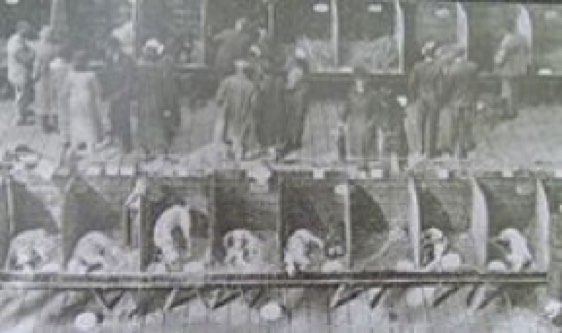
Dogs on display at the 1891 Cruft's dog show
He designed the logo himself, the head of a Saint Bernard surrounded by a collar with a crown on top.

Crufts dog shows enjoyed royal patronage from the start. Queen Victoria's collie, Darnley II, and two of her pomeranians won prizes at the 1891 show. King Edward VII also entered dogs prior to becoming King.
Crufts' royal connection continued in 1897 when the Prince and Princess of Wales (later King Edward VII and Queen Alexandra) entered six dogs, including the prince's lapland sledge dog. All six won prizes. In 1893, Tsar Alexander III of Russia sent eighteen Borzois to compete, and from 1916 King George V entered his Labrador Retrievers regularly. Every British monarch since has been involved in some way.
Mr. Crufts introduced a system where competitors would pay to enter their dogs, and make additional payments if they wished to take the dogs away each night of the three-day competition, and again pay if they wanted to take them away early on the final day. By 1914, the show had grown in popularity until it was recognized as the largest dog show in the world and by 1936 when the show celebrated its Golden Jubilee, over 10,000 dogs were entered at the event. Much of what he did has carried on to present dog shows.
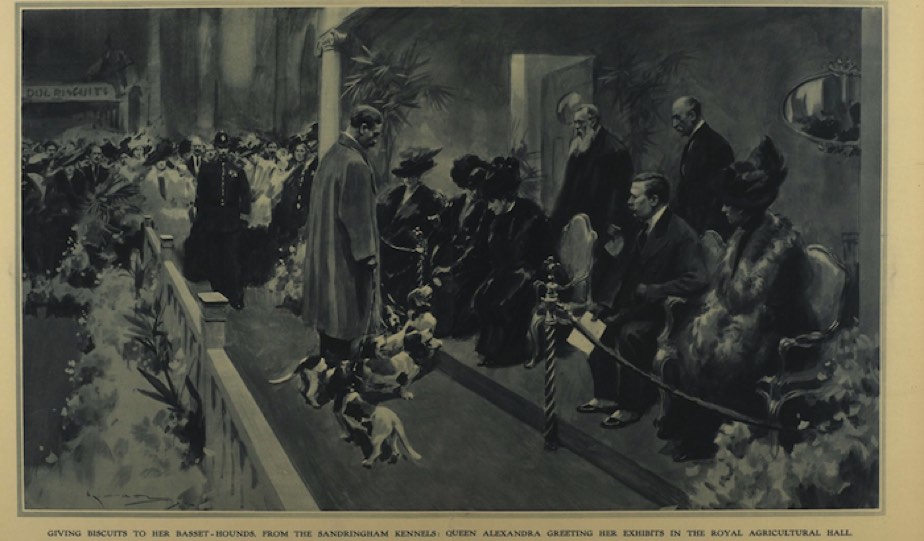
Queen Victoria also entered some of her basset hounds at Crufts as shown in the illustration above. The year of this painting is unknown.
According to the Basset Hound Club (UK) the Basset as we know it today arrived officially in Great Britain in 1866. Basset and Belle were imported from the well-respected kennels of Count le Coulteux de Canteleu, a famous French hound enthusiast. Their new owner, Lord Galway, described them:
They were long, low hounds, shaped much like a Dachshund, with crooked forelegs at the knees and with much more bone and longer heads than on Beagles. They were not the dark tan colour of Dachshunds but the colour of Foxhounds with a certain amount of white about them. Lord Galway's letter to Major C. Henseltine (who's later packs of basset hounds are shown above) that year is the first occurrence of the name "basset hound" in British literature and the first time it was applied to a specific breed. This is considered by many to be the first introduction of pure-bred basset hounds to England and their continued breeding on a scientific basis began as mentioned above.
As stated in the FCI Standaed for Basset Hounds, " The Basset was reputedly bred by monks in France in the Middle Ages to hunt in heavy cover and is able to hold its nose close to the ground. Though closely related to the entire family of French Bassets the breed was developed to perfection in Britain."
In 1876 the first Basset Hound type dog to be shown was in a British show was "Model" (right) owned by Sir Everett Millais. Millais imported "Model" from France in 1874. Lord Onslow’s Finette was bred to Model.
In 1880 Millais coordinated a large Basset Hound entry for the Wolverhampton dog show which brought about public attention to the breed. It wasn’t until 1882 that the "Basset-Hound" was officially recognized by the Kennel Club of England.
It was about this time that Mr. George Krehl imported "Fino de Paris" (center below). Some believe that this male was the pillar the breed in British Basset Hound history. He was one of the Comte de Couteulx's Bassets from France. About 1882 Lord Onslow sold a pack of fifteen hounds to Sir Everett Millais and George Krehl. This illustration is from Cassel's Illustrated Book of the Dog.
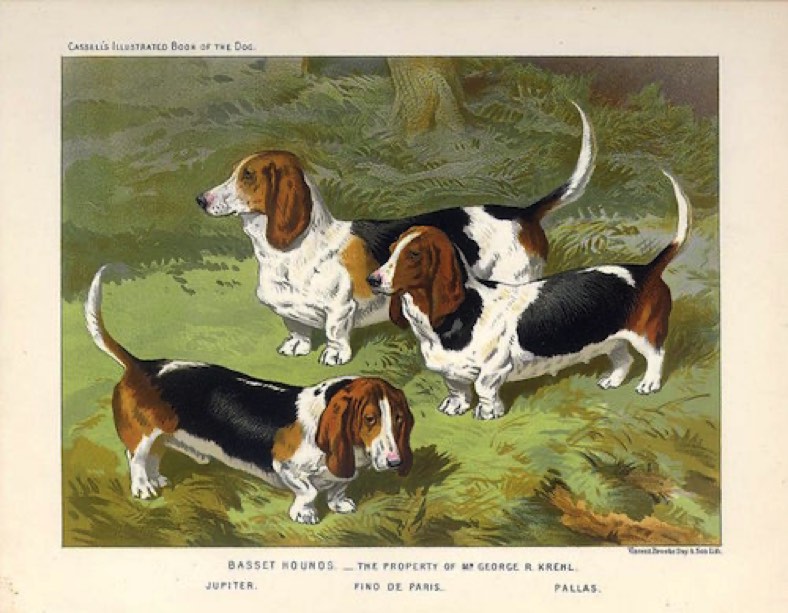
There are many references to short legged hounds through out Europe as early as the 1500s. It is believed that these hounds were descendants of hounds developed by St. Hubert. In Turbeville's Art of Venerie (1576) "St. Huberts are described as being mighty of body, legs low and short, not swift, but good on scent."
Over the pursuing years the St. Hubert evolved in several regions in France. They were used for different quarry based on the region they were in. In 1585 the first mention of "basset" or "low" appears in Jacques de Fouilloux's Venerie describing a hound used to hunt badger. He specifically notes a crooked legged smooth coat hound that works best in undergrowth. As forms of hunting changes to include shooting these hounds spread in popularity through France, where hunting and hound breeding was taken seriously by the ruling classes. They were also found in other parts of Europe.
Unfortunately the French Revolution from 1789 until 1799 put an abrupt end to the ruling classes and also their kennels. Many strains became extinct including the St Hubert.
1866 was a very important year for Basset Hounds as a specific breed as we know them today. The Basset as we know it today arrived officially in Great Britain in 1866. Lord Galway of Serlby imported two examples, Basset and Belle, from the well respected kennels of Count le Coult de Canteleu, a famous French hound enthusiast. In a letter to Major C. Heseltine (of later Walhampton Bassets Pack fame) the first mention of Basset Hound as the name for the breed appeared in British literature. That year was also considered to be the first introduction of Basset Hounds and their continued breeding on a scientific basis began.
In Lord Galway's letter to Heseltine he stated, "In July 1866, I was staying at Royal, Puy de Dome, France where I met the Marquis de Tournon and his son, the Comte de Tournon. The latter promised me a pair of Basset Hounds from his pack, which duly arrived in the automn at Serlby. They were a dog and bitch and I called them "Basset" and "Belle". They were long, low hounds shaped much like a Dachshund, with crooked forelegs at the knees and with much more bone and longer heads than beagles. They were not the dark tan colour of Dachshunds but the colour of Foxhounds with a certain amount of white about them. They had deep heavy tongues more like Foxhounds than beagles."
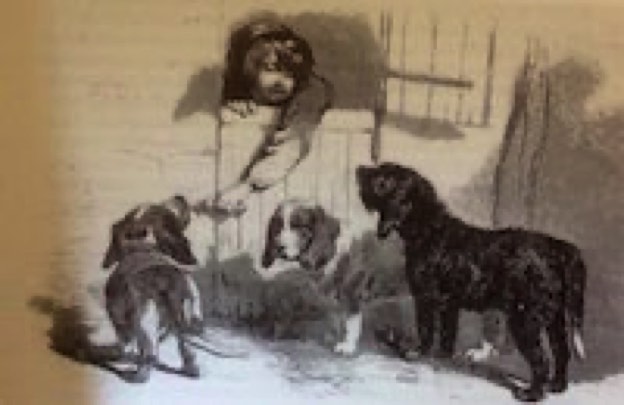
Two Bassets and a Briquette-sized wire hound from Le chien; historie naturelle, races d'utilite et d'ageement by Eugene Gaylot in 1867
The Basset Hounds imported to England by Lord Galway's may have looked like those in this illustration done by Gayot in 1867.
Unfortunately there are no illustrations of Lord Galway's Basset Hounds and records of breedings in those days were not documented like they are today. Also adding to the confusion of the period it was a common practice for several dogs to have the same name.
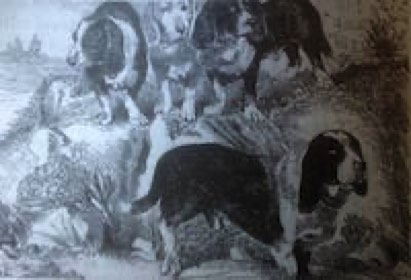
In France, however, this hound has been used for generations, much as we use our Spaniel, as a finder of game in covert, and it has long been a popular sporting dog in Russia and Germany. In early times it was chiefly to be found in Artois and Flanders, where it is supposed to have had its origin; but the home of the better type of Basset is now chiefly in La Vendee, in which department some remarkably fine strains have been produced.
Bassets shown by Pierre Pichot in 1863
Hunting with Basset Hounds in Great Britain.
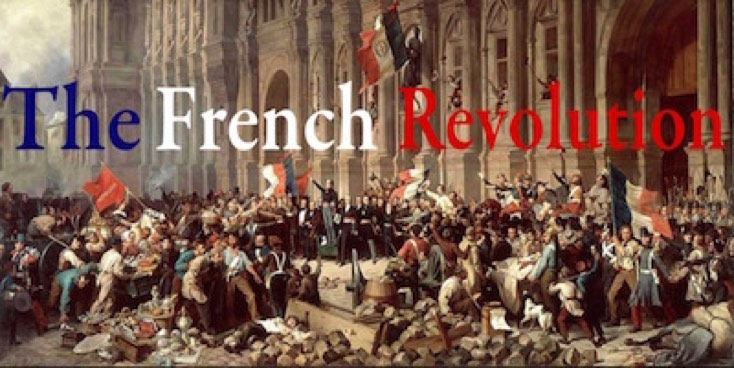
A Basset engraving from Oeuvres Completes De Buffon published in France 1830 - 1832

The engraving at left is one of the best illustrations of a basset in France after the French Revolution.
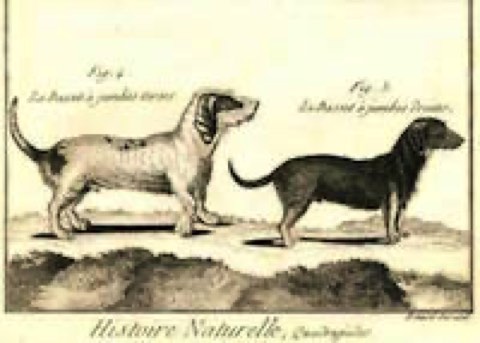
Bassets from Buffon's book on natural history 1797
The engraving at right depicts two different basset breeds during the French Revolution. They survived the purges of the evolution.
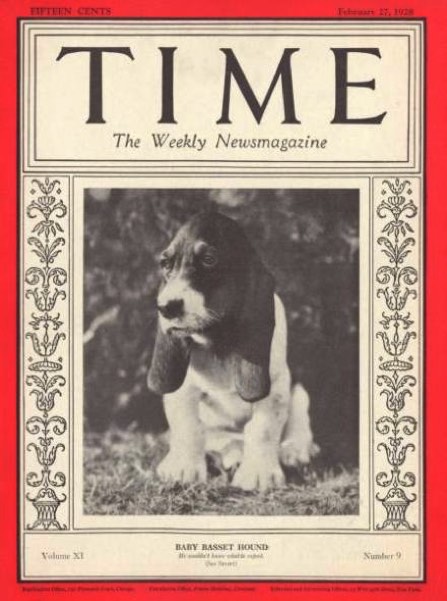
The February 28, 1928 Time magazine covering the 52nd Westminster Dog Show in New York featured a basset puppy on its cover. America fell in love with the melancholy look of the hound and the basset hound began to become a poplar household pet breed.
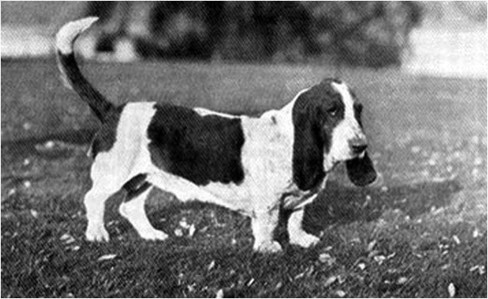
Eng/Am CH Walhampton Andrew - 1925
This section is under construction.
Hunting with basset hounds is a comparatively new feature in British field sports. It dates back little farther than fourteen or fifteen years, and, in fact, may be said not to have been really established on a businesslike footing until the Messrs. Heseltine began to hunt regularly in the year 1891. It is not a sport which, for various reasons, is ever likely to oust beagles or harriers from their ancient popularity. In the first place, bassets are much more difficult to get hold of and more expensive to buy. In the second place, although they have wonderful noses and are most determined workers, they are, from their very conformation, exceedingly slow, and take several hours, usually from two to three, sometimes even more, to wear down their quarry. This style of hunting, although to the chosen few who love hound work before anything else most interesting to watch, is, to the average modem sportsman, inclined to be tedious, and most men would, therefore, prefer to take their pleasure with a faster type of hound. Still, bassets have come to stay ; they are now growing far more numerous than they were a dozen years ago ; many fanciers have become greatly attached to them ; there are a Basset Club and a Stud Book, and each season, among the list of packs of hounds hunting in these islands, there are to be found two or three packs of these bizarre-looking, but wonderfully handsome, hounds.
Before the year 1875, the basset hound was practically unknown in England. He had flourished for ages upon the Continent, chiefly in France and Belgium, as well as, to a lesser extent, in Austria and Germany, where he had been employed for various purposes connected with sport. But in England, prior to that year, the Earl of Onslow was, I believe, the only person who had ever kept bassets in this country. Lord Onslow had, in fact, a kennel of these hounds before the late Sir Everett Millais, who was, next to him, the earliest introducer of them, appeared on the scene. These had been presented to Lord Onslow by the Comte Tournon de Montmelas. In 1875 Sir Everett (then Mr.) Millais first exhibited one of these hounds, the celebrated " Model," which is still often referred to as a typical hound of this curious breed. The basset became quickly a fashion. Sir Everett Millais did much to encourage fanciers, and even wrote a monograph on the new importation,* and before very long — by the year 1883 — this hound had acquired so much of fame and repute as to demand a Club of its own, as well as a place in the Kennel Club Stud Book. Since that time, the march of the basset has, among connoisseurs who can afford the luxury of a new and somewhat expensive fashion, been a triumphant one. In 1883 there were but ten entries of these hounds in the Kennel Club Stud Book, In 1896 there were no less than ninety bassets entered at the Kennel Club Show.
Yet, although the basset has thus achieved a not inconsiderable triumph in a comparatively short period, he is still a somewhat scarce commodity, caviare to the general public. A certain number have seen him on the show benches, or walking abroad with his master ; few have watched him at work in the hunting-field. In appearance, the basset hound looks somewhat like a handsome foxhound — with long ears, deepish flews, and a somewhat old-fashioned type of head — set on extremely squat legs, the fore-legs, especially, being much bent inwards. As to the conformation of the legs, they give, at first, the impression of this hound having some kinship with dachshunds and the old English turnspit. But, as a matter of fact, they are totally distinct. The dachshund is a terrier, while the basset is a pure hound of very ancient descent.
On the Continent this race was, apparently, used very largely for shooting purposes, hunting the country for different kinds of game, and driving it to the guns posted in various positions. In the Ardennes, a bigger breed seems to have been used for driving wolves, boar, and roe ; this is the rough-coated kind, previously referred to. But in various districts this useful hound was, and is, employed for aU kinds of sport, including badger, vermin, and even truffles. A good truffle-hound is, of course, a real treasure. The basset is a most courageous beast and takes readily to the chase of wolf, which ordinary hounds are said to be not very keen about. It is even stated that a well-bred basset will hunt a wolf single-handed, which, considering his inferior size, must be taken as evidence of very high mettle.
The following excerpts from Hare-hunting and Harriers Chapter XVIII - Sport with Basset Hounds by Henry Anderson Bryden (1854 - - 1937) gives a good accounting of early hunting with Basset Hounds in England.
When these hounds were first used for hunting hare in this country, it was quickly discovered that, although they had wonderful noses and were infinitely persevering, they had certain drawbacks which required correction. They are inclined, as I have shown, to dwell too much on the line, and are somewhat too independent, and they are rather easily frightened by the whip. Still, within the last ten years they
The Walhamtopn Packhave shown excellent sport. I find, from my " Field " lists of hounds, that in 1895-96 three packs of bassets were hunting, viz., the Walhampton, the Wintershill, and the Wolvercote. In the next season there were four, viz.. The Walhampton, the Wintershill, the Delapre, and Mr. Moss's.
In 1897-98 the Wintershill dropped out, and the Highworth were added to the other packs. In 1898-99 three packs remained hunting — the Walhampton, the Delapre, and the Highworth. In 1899-1900 the Walhampton apparently held the field alone, to be joined in 1900-01 by the Stoodleigh and the Knowlton. 1901-02 saw two packs again hunting — the ever-faithful Walhampton and Mr. E. H. M. Denny's, the latter hunting from Chiddingstone Castle, Kent — the Knowlton and the Stoodleigh having retired. The Knowlton, it is to be noted, were mastered and hunted by Miss Gladys Peto, to whom two sisters and a brother acted as whippers-in. During the season, 1902-03, the Walhampton and Mr. Denny's were joined by a new pack, the Reepham, hunting near Lincoln.
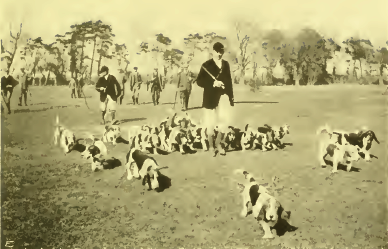
The Walhamtopn Pack
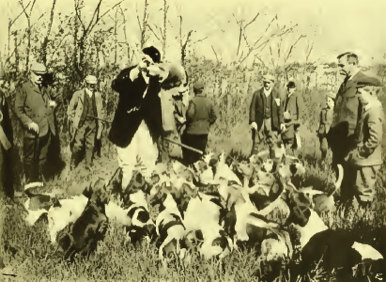
The Walhamton Pack - The Kill
From these particulars it would seem that many people have tried hare-hunting with bassets for a short time, usually a season or two, and have then abandoned it. Whether they found that the sport was somewhat slow, or that these dwarf hounds required more time and patience in their education than they could afford to give them, it is beyond me to say. Probably both reasons led to their abandonment, after a brief trial. In some few instances, no doubt, the pack was started as a mere passing fad or fashion, the owner having acquired a few couples of these hounds and wishing to see how they would behave themselves in the field.
The Walhamton Pack - The KillThe Walhampton pack, as will be seen, have alone remained constant, season after season, to the sport which they inaugurated in 1891. They have been invariably mastered and hunted by the Messrs. Heseltine, Mr. Christopher Heseltine acting as Master, and Captain Godfrey Heseltine having usually carried the horn, except during his absence on service in South Africa.
Major Heseltine's Basset Hound pack is shown below in photographs from Hutchinson's Dog Encylopedia from 1935.
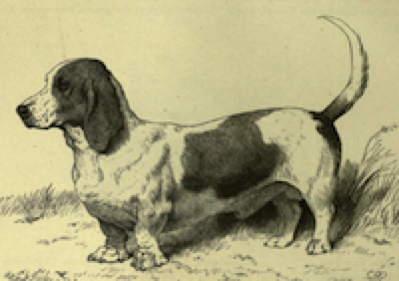
Mr. Everett Millais's Basset Hound Model
by Mr. C. B. Barber
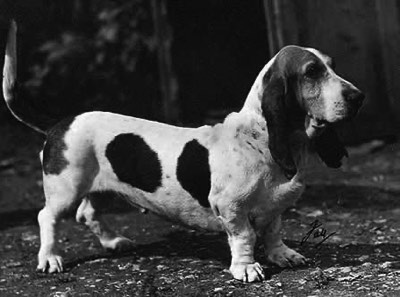
CH. Grims Wishful -1936
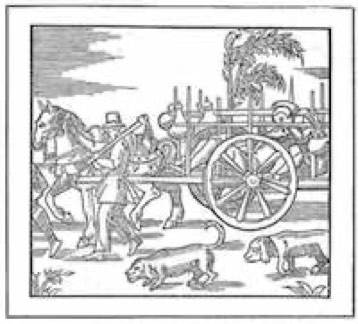
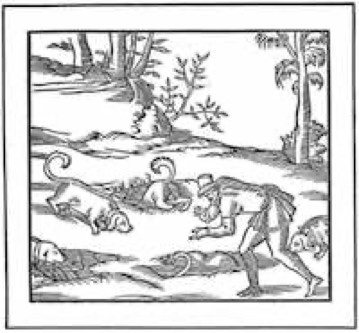
The Basset Hound is a long, low, scenting hound of French ancestry. His many admirers consider him to be among the most beautiful and unusual of all hounds, his dignified look owing in great part to a large, majestic head adorned with long, velvety ears, a wrinkled brow and dark, soulful eyes. The Basset Hound remains one of the most easily recognizable of all dog breeds.
THE Basset Français, or the Basset Hound, as he is known to us, is undoubtedly one of the oldest breeds of dogs, and has existed in France in exactly the same type that he does today for many centuries. The French, however, have kept no systematic records of sports and sporting dogs, and it is only within the last few years, since the English have taken up the breed, that the history of the Basset Hound has been collected and written.
They were down to the seventeenth century known in France as Chiens d'Artois, but since then this name has been transferred to and used only to designate the large Picardy Hounds, and the breed under discussion has been given the name of Basset.
The Basset Français and the Basset Allemand, or, as he is better known, the Dachshund, had undoubtedly a common origin; but the Basset Hound of today has maintained all the characteristics of a true Hound, whereas the Dachshund has some of the attributes of a Terrier.
The Basset was reputedly bred by monks in France in the Middle Ages to hunt in heavy cover and is able to hold its nose close to the ground. Though closely related to the entire family of French Bassets the breed was developed to perfection in Britain. He is a dog capable of hunting his natural prey, the hare, persistently at a relatively slow pace over prodigious distances.
The statement in the Basset Hound Standard for the FEDERATION CYNOLOGIQUE INTERNATIONALE (FCI) states:
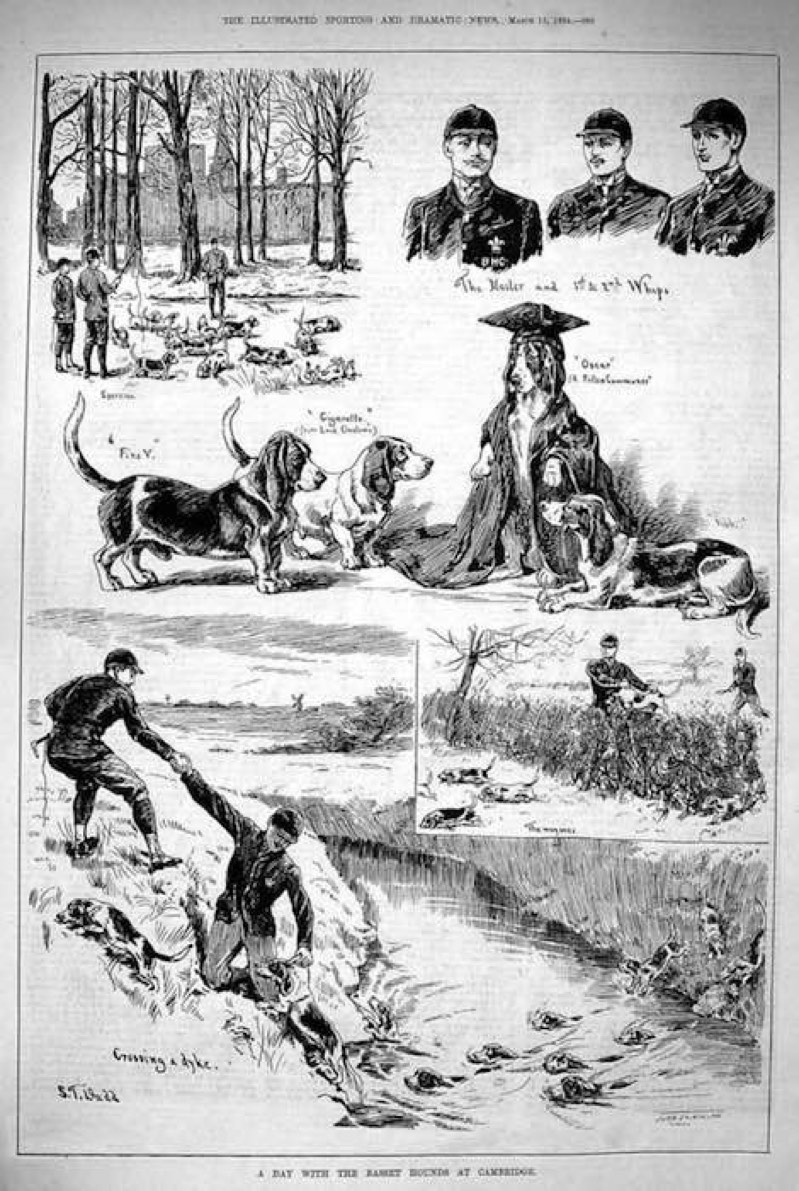
The following page of illustrations from the ILLUSTRATED SPORTING AND DRAMATIC NEWS - March 1884, titled "A DAY WITH THE BASSET HOUNDS AT CAMBRIDGE." shows the scenes of hunting with Basset Hounds in their early days in England some examples of the breed and a little humor as well.
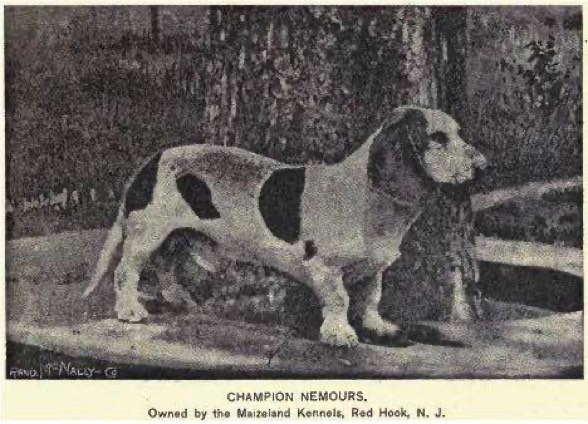
The People's Choice is an American television sitcom that aired on NBC from 1955 to 1958.

While the show's star was Jackie Cooper most Americans fell in love with the show's talking basset hound, Cleo. Much of Cleo's dialog consists of wisecracks. The popularity of the basset hound breed increased markedly with the run of the show.
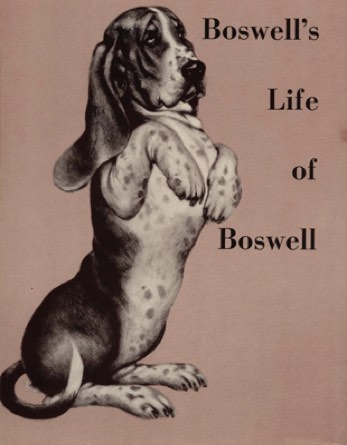
When Boswell's Life of Boswell was published in 1958 it was a big hit with children and parents alike. The book greatly increased the public's interest in basset hounds. This book is one of the most wonderfully illustrated picture books featuring a Basset Hound, ever! Every page features Evelyn Leavens's drawings of her own dog, Boswell (whose photograph is shown, with the author, on the rear flap of the dust jacket). Ms. Leavens considered Boswell an "outstanding model.
NOTE: My plans include expanding this part of basset hound history. It needs to somehow expand that history to more modern times. No, I'm not sure when that task will be addressed. When it does I'll announce it on the website's home page.